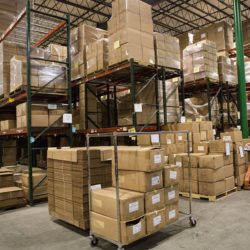Today’s consumers want what they want, when they want it. So, as the demand for goods increases and supply chains become more consumer driven, it is imperative that warehouses replenish their products in picking and reserve areas in the most efficient and cost effective manner. However, there are several efficiency challenges that are plaguing warehouses today. Fortunately, there are also solutions and best practices to combat each of these challenges.
Challenge #1: Limited Real Estate
The biggest challenge to warehouse efficiency and costs with demand-based replenishment is warehouse space. If you have 10,000 different products, it may seem like the best way to display those products would be on the floor, on a pallet. However, to do so you might have to build a warehouse that is five football fields long, which is certainly not very cost effective. Not to mention, efficiency would decrease dramatically because of the time required to travel across the floor to pick orders.
Add to this the fact that many products don’t have the sales volume to justify having considerable real estate on the warehouse floor. Thus, you have a lot of product that is not readily available for picking, which is where automation or other types of systems can play a greater role.
Solution: Automation
High-density automated storage and retrieval systems (AS/RS) enable companies to store more of their product on the floor, without acquiring additional square footage or sacrificing efficiency. Many companies who have implemented AS/RS have reduced their overall building footprint by up to 50 percent (versus conventional warehouses), while at the same time expanding their storage capacity by 30-50 percent.
Challenge #2: Wide-variety of SKUs and Expiration Dates
Standard demand replenishing is not as flexible for certain categories of SKUs that may not be used for full pallet shipments and can lead to possible aging of materials or products. For example, if you are picking only five cases a day off a pallet that has 60 cases and the pallet behind it is there already in queue, it could take you two weeks to deplete the supply of that product.
While this is a huge concern for those dealing with expiration dates in the food industry, other consumer goods manufacturers prefer not to have newer products being shipped out before other products, which may be a few months older.
Solution: Warehouse Execution System (WES)
Depending on the design of the system and the category of SKU or product, you’ll likely have a variety of replenishment schemes embedded in the WES. The first one is the most simple which is, there is space for two pallets and as soon as one is removed, the other one flows forward and the one in the back is now empty, thereby triggering a replenishment. For the slower moving products, users can set up an algorithm within the WES where even if there is space for replenishment, it is not triggered until a future order contains that product.
Challenge #3: Overly-complex Systems
Since the needs of each warehouse are unique, there is no “one size fits all” automation system. The system that works perfectly for the warehouse that ships mostly full pallet orders will not be as efficient in a warehouse that ships a vast number of products in limited quantities.
For example, let’s say one of your customers is Amazon. Every time your warehouse receives an order for a small mug, you have to bring a full pallet down to pick one mug out of it and then return it. You basically could be moving a 2,000 pound load to pick and retrieve a mug. This slows down efficiency and wastes resources.
One of the challenges companies face is the idea that if you are going to have different types of systems that pick different volumes of product, then at some point they all still have to merge together and get out on a truck and go to a customer.
Solution: Planning
This is where the logistics designer comes into play. System plans need to be based on the way products are moving today, while looking toward the future as well. This is where order analytics are used to determine what type of system is suitable for what class of product and how you manage the integration of all these different systems or methodologies of picking. That has to all be coordinated and managed by the WES and the automation. That’s a challenge that requires a lot of thought.
Designing the best system for a warehouse is a careful balance. The logistics designer has to determine how many machines to buy in order for somebody to pick that mug efficiently. They must find the tipping point between using enough automation needed to gain efficiencies and using too much and incurring huge amounts of capital cost for very little return.
These solutions are a starting place in tackling the replenishment challenges faced by warehouses. Since every warehouse’s situation is unique, the ideal solution is one that takes into consideration not only the product movement through the warehouse, but also the business needs of the company as a whole.
Dan Labell is the president, co-owner, and founder for York, PA-based Westfalia Technologies, Inc., a provider of logistics solutions for plants, warehouses and distribution centers. Beginning his career at age 17, Labell worked for Westfalia Germany, a family firm. The experience he gained there led him to study logistics at Syracuse University. After receiving his bachelor’s degree in Transportation Distribution Management and Marketing, Labell secured a job as an assistant project manager for a consulting firm. With interest in opening an automated storage and retrieval company in the U.S., Labell decided to further his education and received a master’s degree in Finance. The same year he received this graduate degree – 1992 – Labellopened the doors to Westfalia, one of his largest accomplishments as a young professional.
Read more at Industrial Distribution

Comments are closed